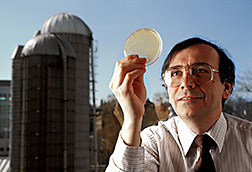New Strain Slows Silage Spoilage
The shiny, dome-topped silos that dot the landscape in the agricultural areas of the Northeast, South, and Midwest do more than just look good. These sleek buildings most often hold either corn, barley, or alfalfa silage—the mainstay feed for about 9.8 million U.S. dairy cows.
Inside the silos, crops ferment in the same manner that pickles and sauerkraut are preserved in glass jars. According to ARS agricultural engineer Richard E. Muck, the fermentation process protects the silage from spoilage by yeasts and molds, as long as the silos are sealed.
Losses in the ensiled crop begin to occur when the silos are opened for animal feeding, or at times when more crop is added. In spite of good management practices, about 5 to 15 percent of an ensiled crop can be spoiled by the growth of aerobic microorganisms.
About a third to half of all dairy farmers use silage inoculants to speed up the fermentation process, spending about $1 per wet ton of crop each year for these inoculants.
"But the silage inoculants farmers buy do only one part of the job that's required for total crop protection: speed up fermentation. They don't consistently reduce growth of yeasts and molds when the silage is exposed to air," says Muck, who works at the U.S. Dairy Forage Research Center in Madison, Wisconsin.
According to Muck, ensiled alfalfa generally resists spoilage better than corn silage. That's why he began studying alfalfa silages that had a natural resistance to spoilage. About 4 years ago, he isolated a strain of Lactobacillus buchneri from one of these resistant silages.
He found that in the presence of oxygen, L. buchneri converts lactic acid to acetic acid which, in turn, inhibits yeast and mold growth.
Muck hopes that the newly discovered organism will be incorporated into a commercial silage inoculant, along with other microorganisms that speed up fermentation. The resulting product should add another dimension to the inoculants now on the market.
Muck expects that adding L. buchneri will also help preserve the crop—even after the silo door is opened. In experiments last fall, he found that only 50,000 microorganisms per gram of silage are needed to effectively protect corn silage against spoilage from yeasts and molds.
"Typically, commercial inoculants are applied at 100,000 or more organisms per gram. So the reduced rate needed for L. buchneri should offset any increased cost of production of this new strain," says Muck.
An inoculant containing L. buchneri and other microorganisms could be commercialized in 1 to 2 years and cost about the same to manufacture as the silage inoculants now on the market.
Muck and ARS will apply for a patent on the organism for its use in a silage inoculant.
These studies were done in collaboration with researchers from Cargill, Inc., of Minneapolis, Minnesota, under the terms of a Cooperative Research and Development Agreement. — By Linda Cooke, ARS.
Richard E. Muck is in the USDA-ARS U.S. Dairy Forage Research Center, 1925 Linden Drive West, Madison, WI 53706; phone (608) 890-0067, fax (608) 890-0076.
"New Strain Slows Silage Spoilage" was published in the June 1995 issue of Agricultural Research magazine.







